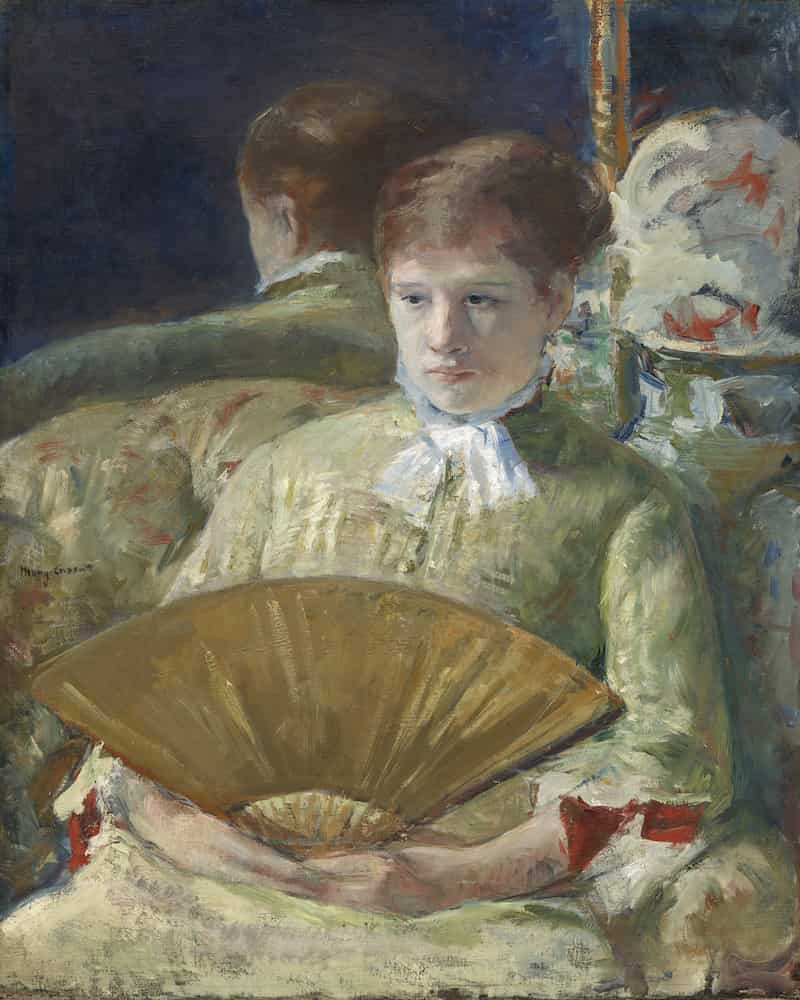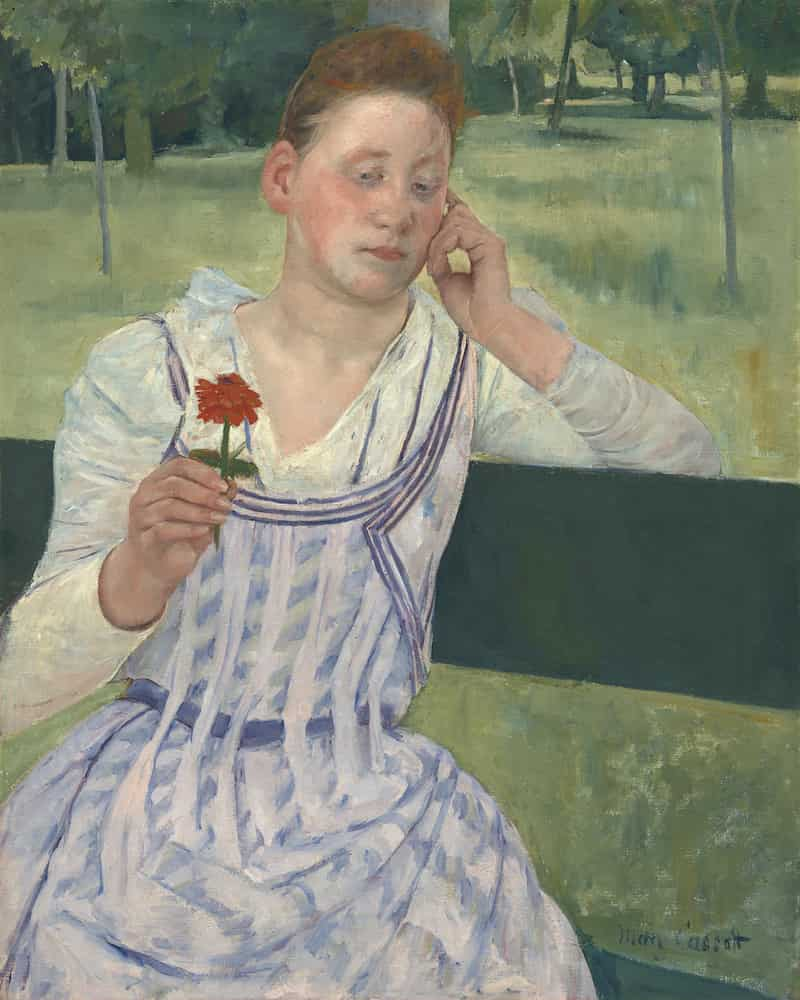Rodrigo Picollo - April 2023
Mary Cassatt

Little Girl in a Blue Armchair, Mary Cassatt
Mary Stevenson Cassatt ( May 22, 1844 – June 14, 1926) was an American painter and printmaker. She was born in Allegheny, Pennsylvania but lived much of her adult life in France, where she befriended Edgar Degas and exhibited with the Impressionists. Cassatt often created images of the social and private lives of women, with particular emphasis on the intimate bonds between mothers and children. She was described by Gustave Geffroy as one of "les trois grandes dames" (the three great ladies) of Impressionism alongside Marie Bracquemond and Berthe Morisot. In 1879, Diego Martelli compared her to Degas, as they both sought to depict movement, light, and design in the most modern sense.

A Woman and a Girl Driving, Mary Cassatt
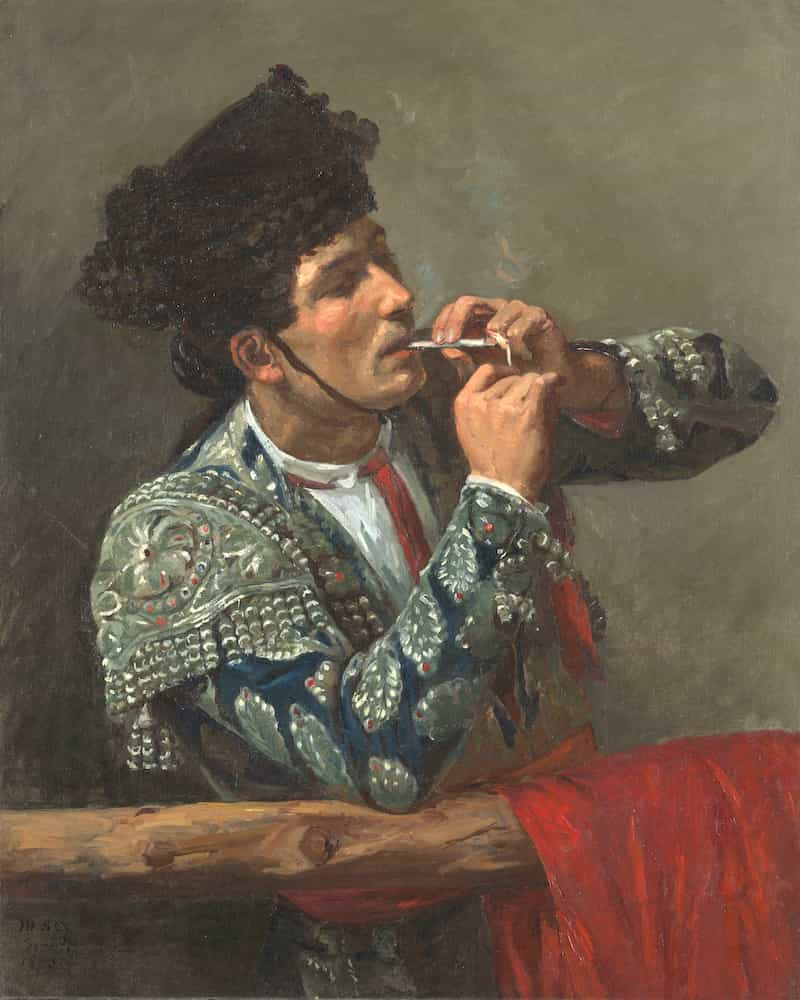
After the Bullfight, Mary Cassatt

Children in a Garden (The Nurse), Mary Cassatt

Girl Arranging Her Hair, Mary Cassatt
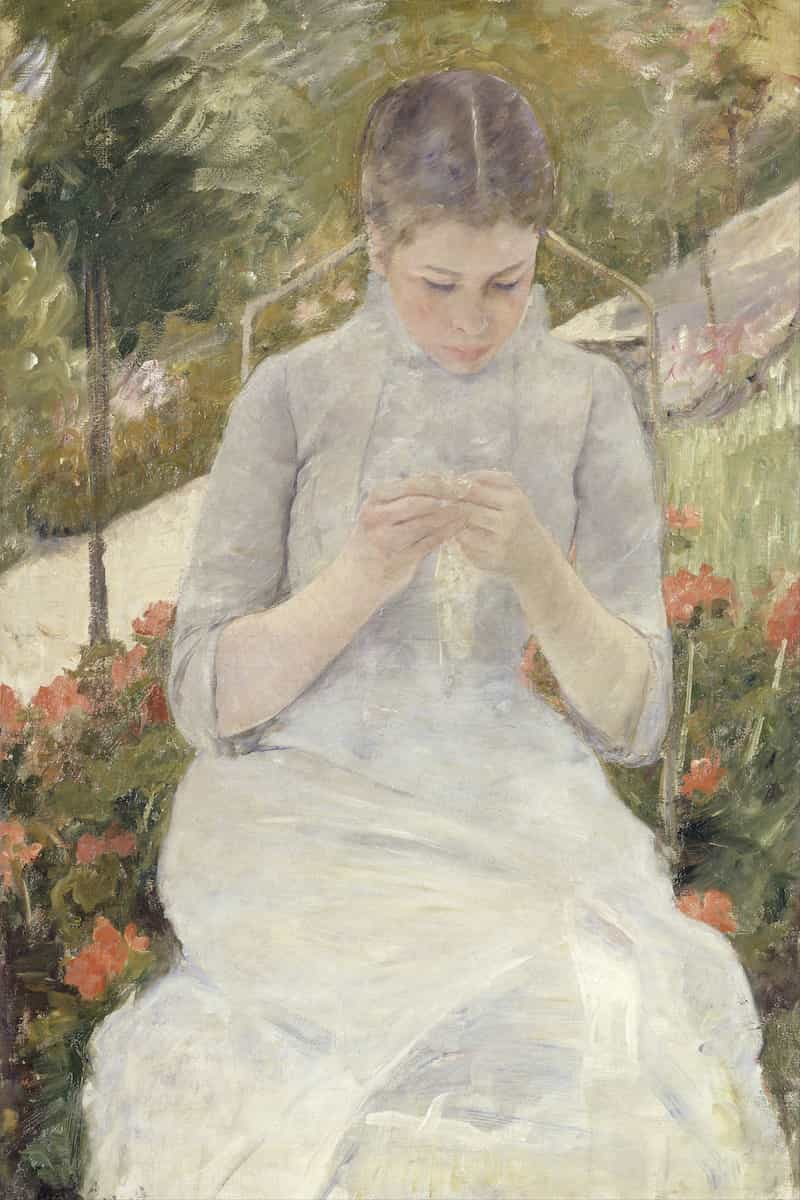
Girl in the Garden, Mary Cassatt
Mary Cassatt- Early Career
A distant cousin of artist Robert Henri, Cassatt was one of seven children, of whom two died in infancy. One brother, Alexander Johnston Cassatt, later became president of the Pennsylvania Railroad. The family moved eastward, first to Lancaster, Pennsylvania, then to the Philadelphia area, where she started her schooling at the age of six. Cassatt grew up in an environment that viewed travel as integral to education; she spent five years in Europe and visited many of the capitals, including London, Paris, and Berlin. While abroad she learned German and French and had her first lessons in drawing and music. It is likely that her first exposure to French artists Jean Auguste Dominique Ingres, Eugène Delacroix, Camille Corot, and Gustave Courbet was at the Paris World's Fair of 1855. Also in the exhibition were Edgar Degas and Camille Pissarro, both of whom were later her colleagues and mentors. Though her family objected to her becoming a professional artist, Cassatt began studying painting at the Pennsylvania Academy of the Fine Arts in Philadelphia at the early age of 15. Part of her parents' concern may have been Cassatt's exposure to feminist ideas and the bohemian behavior of some of the male students. As such, Cassatt and her network of friends were lifelong advocates of equal rights for the sexes. Although about 20% of the students were female, most viewed art as a socially valuable skill; few of them were determined, as Cassatt was, to make art their career. She continued her studies from 1861 through 1865, the duration of the American Civil War. Thomas Eakins was among her fellow students; later Eakins was forced to resign as director of the Academy. Impatient with the slow pace of instruction and the patronizing attitude of the male students and teachers, she decided to study the old masters on her own. She later said: "There was no teaching" at the Academy. Female students could not use live models, until somewhat later, and the principal training was primarily drawing from casts. Cassatt decided to end her studies: At that time, no degree was granted. After overcoming her father's objections, she moved to Paris in 1866, with her mother and family friends acting as chaperones. Since women could not yet attend the École des Beaux-Arts, Cassatt applied to study privately with masters from the school and was accepted to study with Jean-Léon Gérôme, a highly regarded teacher known for his hyper-realistic technique and his depiction of exotic subjects. (A few months later Gérôme also accepted Eakins as a student.) Cassatt augmented her artistic training with daily copying in the Louvre, obtaining the required permit, which was necessary to control the "copyists", usually low-paid women, who daily filled the museum to paint copies for sale. The museum also served as a social place for Frenchmen and American female students, who, like Cassatt, were not allowed to attend cafes where the avant-garde socialized. In this manner, fellow artist and friend Elizabeth Jane Gardner met and married famed academic painter William-Adolphe Bouguereau.
Toward the end of 1866, she joined a painting class taught by Charles Joshua Chaplin, a genre artist. In 1868, Cassatt also studied with artist Thomas Couture, whose subjects were mostly romantic and urban. On trips to the countryside, the students drew from life, particularly the peasants going about their daily activities. In 1868, one of her paintings, A Mandoline Player, was accepted for the first time by the selection jury for the Paris Salon. With Elizabeth Jane Gardner, whose work was also accepted by the jury that year, Cassatt was one of two American women to first exhibit in the Salon. A Mandoline Player is in the Romantic style of Corot and Couture, and is one of only two paintings from the first decade of her career that is documented today. The French art scene was in a process of change, as radical artists such as Courbet and Édouard Manet tried to break away from accepted Academic tradition, and the Impressionists were in their formative years. Cassatt's friend Eliza Haldeman wrote home that artists "are leaving the Academy style and each seeking a new way, consequently just now everything is Chaos." Cassatt, on the other hand, continued to work in the traditional manner, submitting works to the Salon for over ten years, with increasing frustration.
Returning to the United States in the late summer of 1870—as the Franco-Prussian War was starting—Cassatt lived with her family in Altoona. Her father continued to resist her chosen vocation, and paid for her basic needs, but not her art supplies. Cassatt placed two of her paintings in a New York gallery and found many admirers but no purchasers. She was also dismayed at the lack of paintings to study while staying at her summer residence. Cassatt even considered giving up art, as she was determined to make an independent living. She wrote in a letter of July 1871, "I have given up my studio & torn up my father's portrait, & have not touched a brush for six weeks nor ever will again until I see some prospect of getting back to Europe. I am very anxious to go out west next fall & get some employment, but I have not yet decided where." Cassatt traveled to Chicago to try her luck, but lost some of her early paintings in the Great Chicago Fire of 1871. Shortly afterward, her work attracted the attention of Roman Catholic Bishop Michael Domenec of Pittsburgh, who commissioned her to paint two copies of paintings by Correggio in Parma, Italy, advancing her enough money to cover her travel expenses and part of her stay. In her excitement she wrote, "O how wild I am to get to work, my fingers farely itch & my eyes water to see a fine picture again". With Emily Sartain, a fellow artist from a well-regarded artistic family from Philadelphia, Cassatt set out for Europe again.
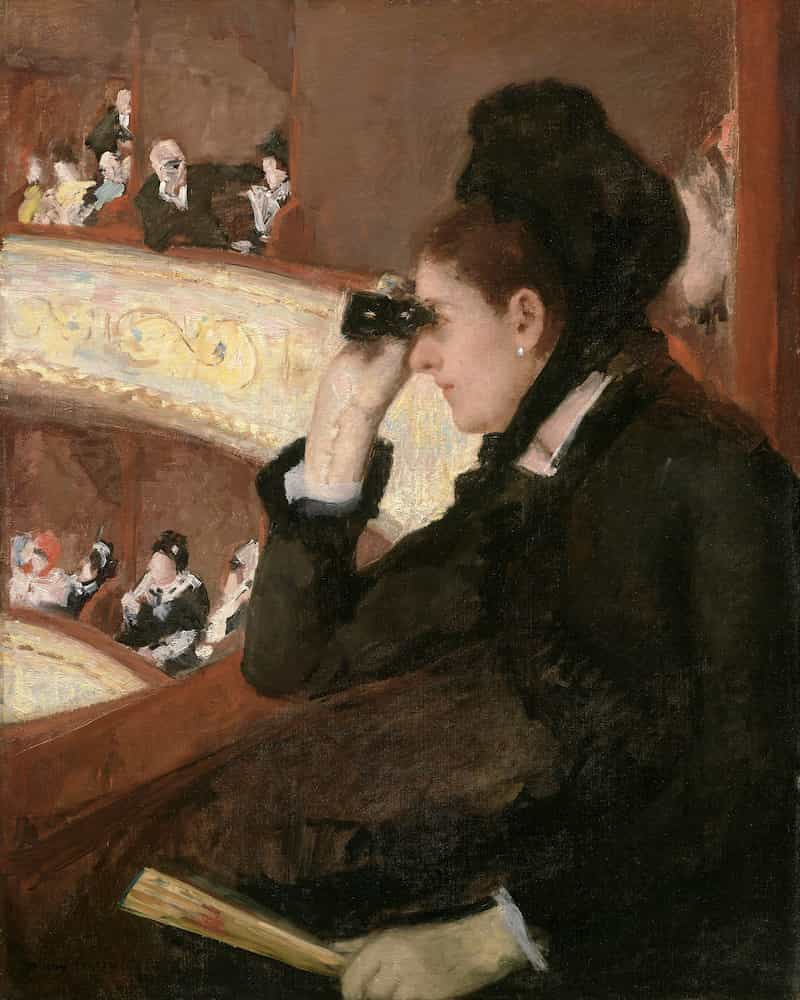
In the Loge, Mary Cassatt

Mother and Child, Mary Cassatt

Self Portrait, Mary Cassatt
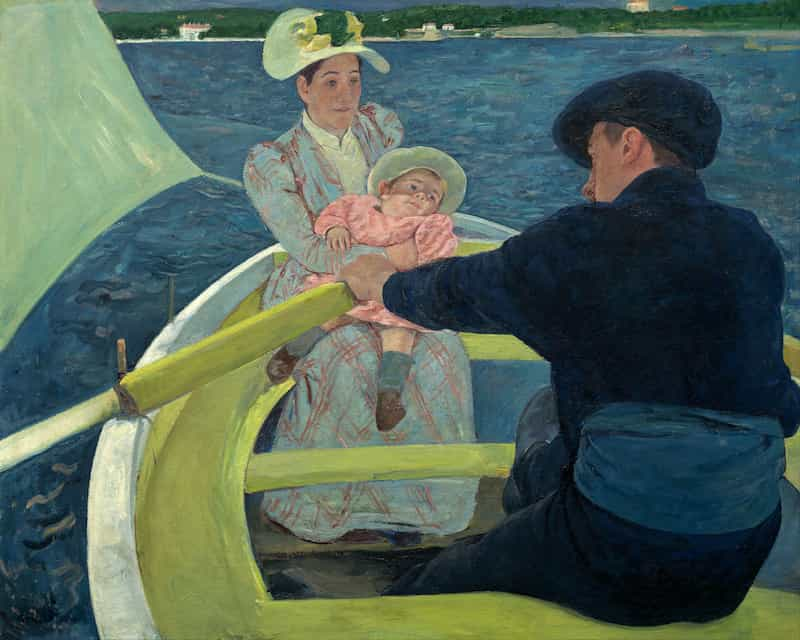
The Boating Party, Mary Cassatt
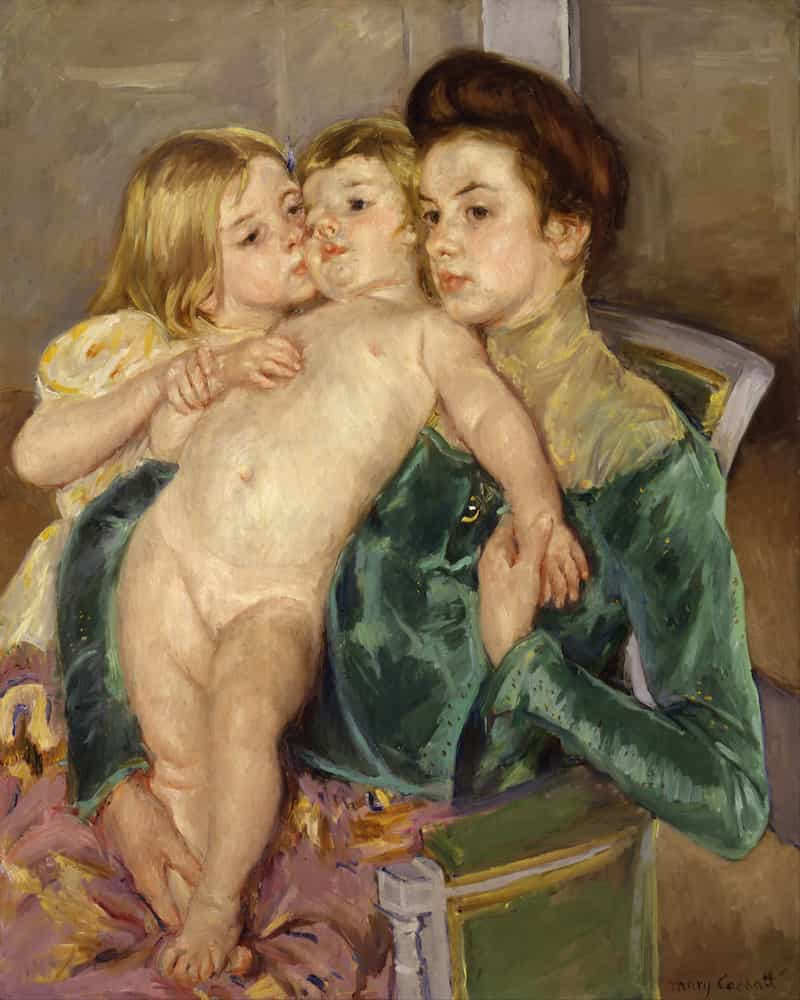
The Caress, Mary Cassatt
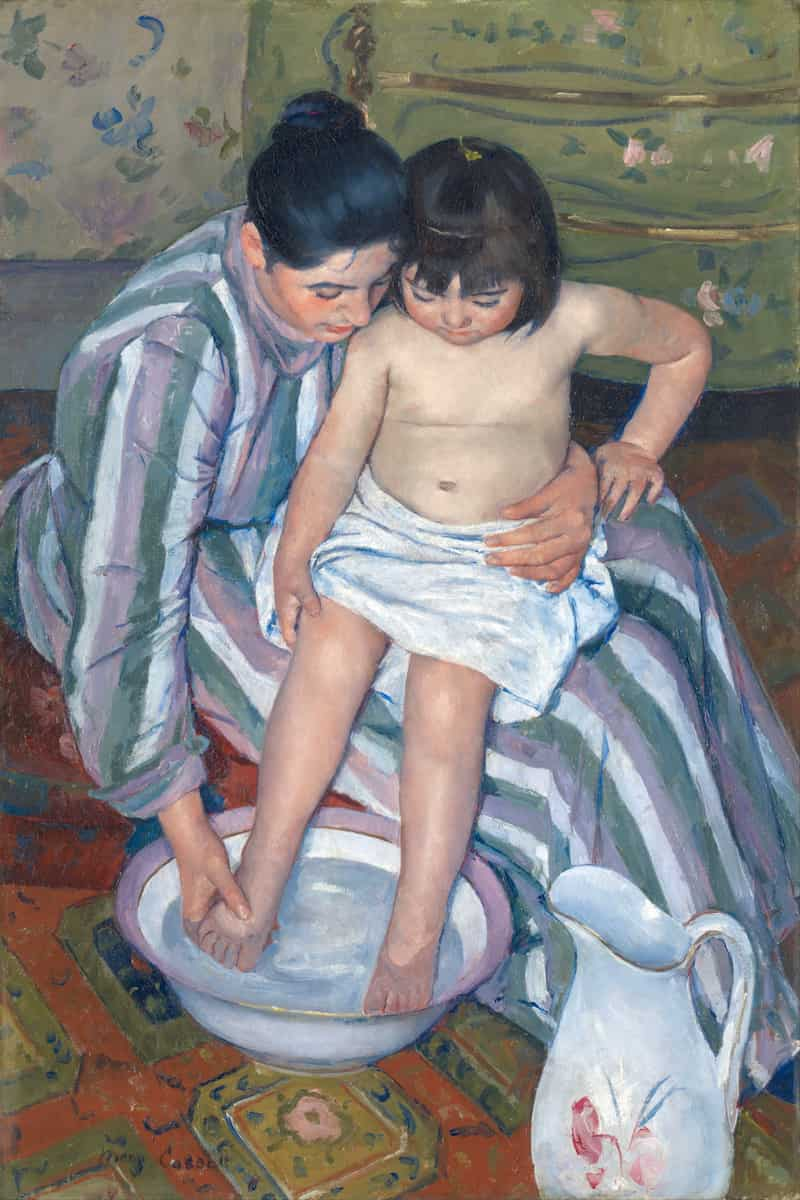
The Child's Bath, Mary Cassatt
Mary Cassatt - Impressionism
Within months of her return to Europe in the autumn of 1871, Cassatt's prospects had brightened. Her painting Two Women Throwing Flowers During Carnival was well received in the Salon of 1872, and was purchased. She attracted much favorable notice in Parma and was supported and encouraged by the art community there: "All Parma is talking of Miss Cassatt and her picture, and everyone is anxious to know her".
After completing her commission for the bishop, Cassatt traveled to Madrid and Seville, where she painted a group of paintings of Spanish subjects, including Spanish Dancer Wearing a Lace Mantilla (1873, in the National Museum of American Art, Smithsonian Institution). In 1874, she made the decision to take up residence in France. She was joined by her sister Lydia who shared an apartment with her. Cassatt opened a studio in Paris. Louisa May Alcott's sister, Abigail May Alcott, was then an art student in Paris and visited Cassatt. Cassatt continued to express criticism of the politics of the Salon and the conventional taste that prevailed there. She was blunt in her comments, as reported by Sartain, who wrote: "she is entirely too slashing, snubs all modern art, disdains the Salon pictures of Cabanel, Bonnat, all the names we are used to revere". Cassatt saw that works by female artists were often dismissed with contempt unless the artist had a friend or protector on the jury, and she would not flirt with jurors to curry favor. Her cynicism grew when one of the two pictures she submitted in 1875 was refused by the jury, only to be accepted the following year after she darkened the background. She had quarrels with Sartain, who thought Cassatt too outspoken and self-centered, and eventually they parted. Out of her distress and self-criticism, Cassatt decided that she needed to move away from genre paintings and onto more fashionable subjects, in order to attract portrait commissions from American socialites abroad, but that attempt bore little fruit at first.
In 1877, both her entries were rejected, and for the first time in seven years she had no works in the Salon. At this low point in her career she was invited by Edgar Degas to show her works with the Impressionists, a group that had begun their own series of independent exhibitions in 1874 with much attendant notoriety. The Impressionists (also known as the "Independents" or "Intransigents") had no formal manifesto and varied considerably in subject matter and technique. They tended to prefer plein air painting and the application of vibrant color in separate strokes with little pre-mixing, which allows the eye to merge the results in an "impressionistic" manner. The Impressionists had been receiving the wrath of the critics for several years. Henry Bacon, a friend of the Cassatts, thought that the Impressionists were so radical that they were "afflicted with some hitherto unknown disease of the eye". They already had one female member, artist Berthe Morisot, who became Cassatt's friend and colleague.
Cassatt admired Degas, whose pastels had made a powerful impression on her when she encountered them in an art dealer's window in 1875. "I used to go and flatten my nose against that window and absorb all I could of his art," she later recalled. "It changed my life. I saw art then as I wanted to see it." She accepted Degas' invitation with enthusiasm and began preparing paintings for the next Impressionist show, planned for 1878, which (after a postponement because of the World's Fair) took place on April 10, 1879. She felt comfortable with the Impressionists and joined their cause enthusiastically, declaring: "we are carrying on a despairing fight & need all our forces". Unable to attend cafes with them without attracting unfavorable attention, she met with them privately and at exhibitions. She now hoped for commercial success selling paintings to the sophisticated Parisians who preferred the avant-garde. Her style had gained a new spontaneity during the intervening two years. Previously a studio-bound artist, she had adopted the practice of carrying a sketchbook with her while out-of-doors or at the theater, and recording the scenes she saw.
In 1877, Cassatt was joined in Paris by her father and mother, who returned with her sister Lydia, all eventually to share a large apartment on the fifth floor of 13, Avenue Trudaine. Mary valued their companionship, as neither she nor Lydia had married. A case was made that Mary suffered from narcissistic disturbance, never completing the recognition of herself as a person outside of the orbit of her mother. Mary had decided early in life that marriage would be incompatible with her career. Lydia, who was frequently painted by her sister, suffered from recurrent bouts of illness, and her death in 1882 left Cassatt temporarily unable to work. Cassatt's father insisted that her studio and supplies be covered by her sales, which were still meager. Afraid of having to paint "potboilers" to make ends meet, Cassatt applied herself to produce some quality paintings for the next Impressionist exhibition. Three of her most accomplished works from 1878 were Portrait of the Artist (self-portrait), Little Girl in a Blue Armchair, and Reading Le Figaro (portrait of her mother).
Degas had considerable influence on Cassatt. Both were highly experimental in their use of materials, trying distemper and metallic paints in many works, such as Woman Standing Holding a Fan, 1878–79 (Amon Carter Museum of American Art). She became extremely proficient in the use of pastels, eventually creating many of her most important works in this medium. Degas also introduced her to etching, of which he was a recognized master. The two worked side by side for a while, and her draftsmanship gained considerable strength under his tutelage. One example of her thoughtful approach to the medium of drypoint as a mode for reflecting on her status as an artist is 'Reflection' of 1889–90, which has recently been interpreted as a self-portrait. Degas in turn depicted Cassatt in a series of etchings recording their trips to the Louvre. She treasured his friendship but learned not to expect too much from his fickle and temperamental nature after a project they were collaborating on at the time, a proposed journal devoted to prints, was abruptly dropped by him. The sophisticated and well-dressed Degas, then forty-five, was a welcome dinner guest at the Cassatt residence, and likewise they at his soirées. The Impressionist exhibit of 1879 was the most successful to date, despite the absence of Renoir, Sisley, Manet and Cézanne, who were attempting once again to gain recognition at the Salon. Through the efforts of Gustave Caillebotte, who organized and underwrote the show, the group made a profit and sold many works, although the criticism continued as harsh as ever. The Revue des Deux Mondes wrote, "M. Degas and Mlle. Cassatt are, nevertheless, the only artists who distinguish themselves... and who offer some attraction and some excuse in the pretentious show of window dressing and infantile daubing". Cassatt displayed eleven works, including Lydia in a Loge, Wearing a Pearl Necklace, (Woman in a Loge). Although critics claimed that Cassatt's colors were too bright and that her portraits were too accurate to be flattering to the subjects, her work was not savaged as was Monet's, whose circumstances were the most desperate of all the Impressionists at that time. She used her share of the profits to purchase a work by Degas and one by Monet. She participated in the Impressionist Exhibitions that followed in 1880 and 1881, and she remained an active member of the Impressionist circle until 1886. In 1886, Cassatt provided two paintings for the first Impressionist exhibition in the US, organized by art dealer Paul Durand-Ruel. Her friend Louisine Elder married Harry Havemeyer in 1883, and with Cassatt as advisor, the couple began collecting the Impressionists on a grand scale. Much of their vast collection is now in the Metropolitan Museum of Art in New York City. Cassatt also made several portraits of family members during that period, of which Portrait of Alexander Cassatt and His Son Robert Kelso (1885) is one of her best regarded. Cassatt's style then evolved, and she moved away from Impressionism to a simpler, more straightforward approach. She began to exhibit her works in New York galleries as well. After 1886, Cassatt no longer identified herself with any art movement and experimented with a variety of techniques.
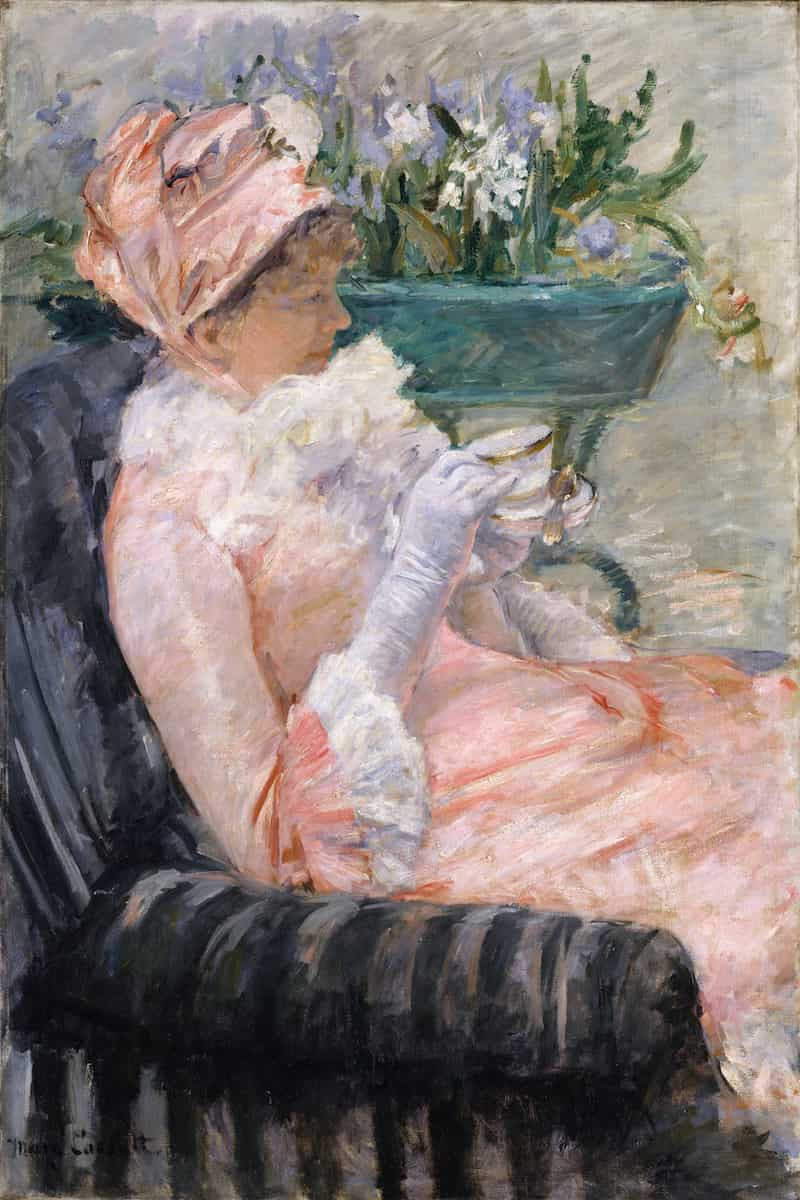
The Cup of Tea, Mary Cassatt
Mary Cassatt - Feminist Viewpoints
Cassatt and her contemporaries enjoyed the wave of feminism that occurred in the 1840s, allowing them access to educational institutions at newly coed colleges and universities, such as Oberlin and the University of Michigan. Likewise, women's colleges such as Vassar, Smith and Wellesley opened their doors during this time. Cassat was an outspoken advocate for women's equality, campaigning with her friends for equal travel scholarships for students in the 1860s, and the right to vote in the 1910s. Mary Cassatt depicted the "New Woman" of the 19th century from the woman's perspective. As a successful, highly trained woman artist who never married, Cassatt—like Ellen Day Hale, Elizabeth Coffin, Elizabeth Nourse and Cecilia Beaux—personified the "New Woman". She "initiated the profound beginnings in recreating the image of the 'new' women", drawn from the influence of her intelligent and active mother, Katherine Cassatt, who believed in educating women to be knowledgeable and socially active. She is depicted in Reading 'Le Figaro' (1878). Although Cassatt did not explicitly make political statements about women's rights in her work, her artistic portrayal of women was consistently done with dignity and the suggestion of a deeper, meaningful inner life. Cassatt objected to being stereotyped as a "woman artist", she supported women's suffrage, and in 1915 showed eighteen works in an exhibition supporting the movement organised by Louisine Havemeyer, a committed and active feminist. The exhibition brought her into conflict with her sister-in-law Eugenie Carter Cassatt, who was anti-suffrage and who boycotted the show along with Philadelphia society in general. Cassatt responded by selling off her work that was otherwise destined for her heirs. In particular The Boating Party, thought to have been inspired by the birth of Eugenie's daughter Ellen Mary, was bought by the National Gallery, Washington DC.
Mary Cassatt - Relationship with Degas
Cassatt and Degas had a long period of collaboration. The two painters had studios close together, Cassatt at 19, rue Laval, Degas at 4, rue Frochot, less than a five-minute stroll apart, and Degas developed the habit of looking in at Cassatt's studio and offering her advice and helping her gain models. They had much in common: they shared similar tastes in art and literature, came from affluent backgrounds, had studied painting in Italy, and both were independent, never marrying. The degree of intimacy between them cannot be assessed now, as no letters survive, but it is unlikely they were in a relationship given their conservative social backgrounds and strong moral principles. Several of Vincent van Gogh's letters attest Degas' sexual continence. Degas introduced Cassatt to pastel and engraving, both of which Cassatt quickly mastered, while for her part Cassatt was instrumental in helping Degas sell his paintings and promoting his reputation in America. Both regarded themselves as figure painters, and the art historian George Shackelford suggests they were influenced by the art critic Louis Edmond Duranty's appeal in his pamphlet The New Painting for a revitalization in figure painting: "Let us take leave of the stylized human body, which is treated like a vase. What we need is the characteristic modern person in his clothes, in the midst of his social surroundings, at home or out in the street."
After Cassatt's parents and sister Lydia joined Cassatt in Paris in 1877, Degas, Cassatt, and Lydia were often to be seen at the Louvre studying artworks together. Degas produced two prints, notable for their technical innovation, depicting Cassatt at the Louvre looking at artworks while Lydia reads a guidebook. These were destined for a prints journal planned by Degas (together with Camille Pissarro and others), which never came to fruition. Cassatt frequently posed for Degas, notably for his millinery series trying on hats.
Around 1884, Degas made a portrait in oils of Cassatt, Mary Cassatt Seated, Holding Cards.[a] A Self-Portrait (c. 1880) by Cassatt depicts her in the identical hat and dress, leading art historian Griselda Pollock to speculate they were executed in a joint painting session in the early years of their acquaintance. Cassatt and Degas worked most closely together in the fall and winter of 1879–80 when Cassatt was mastering her printmaking technique. Degas owned a small printing press, and by day she worked at his studio using his tools and press while in the evening she made studies for the etching plate the next day. However, in April 1880, Degas abruptly withdrew from the prints journal they had been collaborating on, and without his support the project folded. Degas' withdrawal piqued Cassatt who had worked hard at preparing a print, In the Opera Box, in a large edition of fifty impressions, no doubt destined for the journal. Although Cassatt's warm feelings for Degas were to last her entire life, she never again worked with him as closely as she had over the prints journal. Mathews notes that she ceased executing her theater scenes at this time. Degas was forthright in his views, as was Cassatt. They clashed over the Dreyfus affair (early in her career she had executed a portrait of the art collector Moyse Dreyfus, a relative of the court-martialled lieutenant at the center of the affair). Cassatt later expressed satisfaction at the irony of Lousine Havermeyer's 1915 joint exhibition of hers and Degas' work being held in aid of women's suffrage, equally capable of affectionately repeating Degas' antifemale comments as being estranged by them (when viewing her Two Women Picking Fruit for the first time, he had commented "No woman has the right to draw like that"). From the 1890s onwards their relationship took on a decidedly commercial aspect, as in general had Cassatt's other relations with the Impressionist circle; nevertheless they continued to visit each other until Degas died in 1917.

Young Mother Sewing, Mary Cassatt
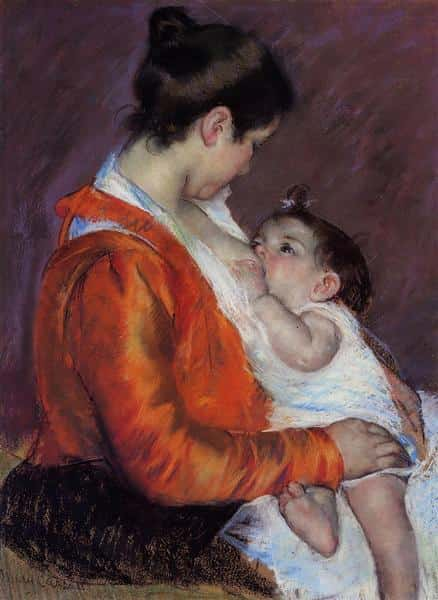
Louise Nursing her Child, Mary Cassatt
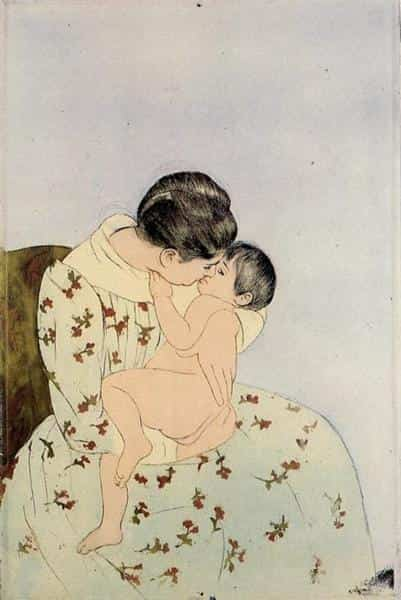
The Kiss, Mary Cassatt

After the Bath, Mary Cassatt
Mary Cassatt - Later Life
Cassatt's reputation is based on an extensive series of rigorously drawn and tenderly observed paintings and prints on the theme of the mother and child. The earliest dated work on this subject is the drypoint Gardner Held by His Mother (an impression inscribed "Jan/88" is in the New York Public Library), although she had painted a few earlier works on the theme. Some of these works depict her own relatives, friends, or clients, although in her later years she generally used professional models in compositions that are often reminiscent of Italian Renaissance depictions of the Madonna and Child. After 1900, she concentrated almost exclusively on mother-and-child subjects, such as Woman with a Sunflower. Viewers may be surprised to find that despite her focus on portraying mother-child pairs in her portraits, "Cassatt rejected the idea of becoming a wife and mother..." The 1890s were Cassatt's busiest and most creative period. She had matured considerably and became more diplomatic and less blunt in her opinions. She also became a role model for young American artists who sought her advice. Among them was Lucy A. Bacon, whom Cassatt introduced to Camille Pissarro. Though the Impressionist group disbanded, Cassatt still had contact with some of the members, including Renoir, Monet, and Pissarro.
In 1891, she exhibited a series of highly original colored drypoint and aquatint prints, including Woman Bathing and The Coiffure, inspired by the Japanese masters shown in Paris the year before. Cassatt was attracted to the simplicity and clarity of Japanese design, and the skillful use of blocks of color. In her interpretation, she used primarily light, delicate pastel colors and avoided black (a "forbidden" color among the Impressionists). Adelyn D. Breeskin, the author of two catalogue raisonnés of Cassatt's work, comments that these colored prints, "now stand as her most original contribution... adding a new chapter to the history of graphic arts...technically, as color prints, they have never been surpassed".
Also in 1891, Chicago businesswoman Bertha Palmer approached Cassatt to paint a 12' × 58' mural about "Modern Woman" for the Women's Building for the World's Columbian Exposition to be held in 1893. Cassatt completed the project over the next two years while living in France with her mother. The mural was designed as a triptych. The central theme was titled Young Women Plucking the Fruits of Knowledge or Science. The left panel was Young Girls Pursuing Fame and the right panel Arts, Music, Dancing. The mural displays a community of women apart from their relation to men, as accomplished persons in their own right. Palmer considered Cassatt to be an American treasure and could think of no one better to paint a mural at an exposition that was to do so much to focus the world's attention on the status of women. The mural did not survive following the run of the exhibition when the building was torn down. Cassatt made several studies and paintings on themes similar to those in the mural, so it is possible to see her development of those ideas and images. Cassatt also exhibited other paintings in the Exposition.
As the new century arrived, Cassatt served as an advisor to several major art collectors and stipulated that they eventually donate their purchases to American art museums. In recognition of her contributions to the arts, France awarded her the Légion d'honneur in 1904. Although instrumental in advising American collectors, recognition of her art came more slowly in the United States. Even among her family members back in America, she received little recognition and was totally overshadowed by her famous brother.
Mary Cassatt's brother, Alexander Cassatt, was president of the Pennsylvania Railroad from 1899 until his death in 1906. She was shaken, as they had been close, but she continued to be very productive in the years leading up to 1910. An increasing sentimentality is apparent in her work of the 1900s; her work was popular with the public and the critics, but she was no longer breaking new ground, and her Impressionist colleagues who once provided stimulation and criticism were dying. She was hostile to such new developments in art as post-Impressionism, Fauvism and Cubism. Two of her works appeared in the Armory Show of 1913, both images of a mother and child.
A trip to Egypt in 1910 impressed Cassatt with the beauty of its ancient art, but was followed by a crisis of creativity; not only had the trip exhausted her, but she declared herself "crushed by the strength of this Art", saying, "I fought against it but it conquered, it is surely the greatest Art the past has left us ... how are my feeble hands to ever paint the effect on me." Diagnosed with diabetes, rheumatism, neuralgia, and cataracts in 1911, she did not slow down, but after 1914 she was forced to stop painting as she became almost blind.
Cassatt died on June 14, 1926 at Château de Beaufresne, near Paris, and was buried in the family vault at Le Mesnil-Théribus, France.
Mary Cassatt - The Complete Works
| Title | Date Painted |
|---|---|
| Child Drinking Milk | 1868 |
| Two Seated Women | 1869 |
| Sketch of Mrs. Currey Sketch of Mr. Cassatt | 1871 |
| Bacchante | 1872 |
| Portrait Of A Woman | 1872 |
| During Carnival | 1872 |
| The Flirtation A Balcony in Seville | 1872 |
| The Mandolin Player | 1872 |
| A Baby Smiling at Two Young Women | 1873 |
| Head of a Young Woman | 1873 |
| Mrs. Robert Simpson Cassatt | 1873 |
| Offering the Panel to the Bullfighter | 1872-3 |
| Portrait of a Lady of Seville | 1873 |
| Portrait of Madame Sisley | 1873 |
| Profile of an Italian Woman | 1873 |
| Spanish Dancer Wearing a Lace Mantilla | 1873 |
| Toreador | 1873 |
| Musical Party | 1874 |
| Portrait of Madame Cordier | 1874 |
| Peasant Woman Peeling an Orange | 1875 |
| The Young Bride | 1875 |
| Woman on a Striped Sofa with a Dog | 1875 |
| Head of a Young Girl | 1876 |
| Portrait of Miss Cassatt, holding the cards | 1876 |
| Mary Ellison Embroidering | 1877 |
| Portrait of a Lady (Miss My Ellison) | 1877 |
| Children in a Garden | 1878 |
| Little Girl in a Blue Armchair | 1878 |
| Portrait of Madame X Dressed for the Matinee | 1878 |
| Portrait Of The Artist | 1878 |
| The Opera | 1877-8 |
| The Reader | 1878 |
| At the Theater | 1878-9 |
| In the Box | 1879 |
| Moses Dreyfus | 1879 |
| Mother Combing Her Child’s Hair | 1879 |
| Portrait of girl | 1879 |
| The Cup of Tea | 1879 |
| Theater | 1879 |
| Woman Reading | 1878-9 |
| Woman Standing, Holding a Fan | 1878-9 |
| Woman with a Pearl Necklace | 1879 |
| Elsie Cassatt Holding a Big Dog | 1880 |
| Elsie in a Blue Chair | 1880 |
| Lady with a Fan (Portrait of Anne Chlotte Gailld) | 1880 |
| Lilacs in a Window | 1880 |
| Lydia Cassatt in a Green Bonnet and a Coat | 1880 |
| Lydia Cassatt Leaning on Her Arms, Seated in a Loge | 1880 |
| Lydia crocheting in the garden at marly | 1880 |
| Lydia Seated in the Garden with a Dog in Her Lap | 1880 |
| Mother about to Wash her Sleepy Child | 1880 |
| Mother and Child | 1880 |
| Mrs Cassatt Reading to her Grandchildren | 1880 |
| Mrs. Gardner Cassatt in Black | 1880 |
| Portrait Of Alexander Cassatt | 1880 |
| Portrait of Alexander J. Cassatt | 1880 |
| Portrait of Mlle C. Lydia Cassatt | 1880 |
| Red poppies | 1874-80 |
| Self Portrait | 1880 |
| The Loge | 1880 |
| The Tea | 1879-80 |
| The Visitor | 1880 |
| Woman by a Window Feeding Her Dog | 1880 |
| Woman Reading in a Garden | 1880 |
| Young Girl Holding a Loose Bouquet | 1880 |
| A woman and child in the driving seat | 1881 |
| Lydia at the Tapestry Loom | 1880-1 |
| Lydia Reading on a Divan | 1880-1 |
| Susan Comforting the Baby (no.1) | 1881 |
| Susan Comforting the Baby (no.2) | 1881 |
| Susan in a Toque Trimmed with Two Roses | 1881 |
| Susan Seated Outdoors Wearing a Purple Hat | 1881 |
| Woman and Child Seated in a Garden | 1881 |
| Lydia Sitting on a Porch, Crocheting | 1881-2 |
| Master Robert Kelso Cassatt | 1882 |
| Robert and His Sailboat | 1882 |
| Woman in Black | 1882 |
| Young Woman Sewing in the garden | 1880-2 |
| Portrait of an elderly lady | 1883 |
| Susan on a balcony holding a dog | 1883 |
| Children Playing On The Beach | 1884 |
| Lady at the Tea Table | 1885 |
| Mr. Robert S. Cassatt on Horseback | 1885 |
| Portrait of Alexander J. Cassat and His Son Robert Kelso Cassatt | 1884-5 |
| The Sisters | 1885 |
| Child In A Straw Hat | 1886 |
| Girl ranging Her Hair | 1886 |
| Woman ranging Her Veil | 1886 |
| Young Girl with Brown Hair | 1880-7 |
| Young Woman Sewing in the Garden | 1887 |
| Mother’s Goodnight Kiss | 1888 |
| Woman and Child | 1887-8 |
| At the Window | 1889 |
| Baby in His Mother`s arms, sucking his finger | 1889 |
| Emmie and Her Child | 1889 |
| Helene de Septeuil | 1889 |
| Mathilde Holding a Baby Who Reaches out to the Right | 1889 |
| Mother And Child | 1889 |
| Mother and Child | 1889 |

| Title | Date Painted |
|---|---|
| Mrs. Robert S. Cassatt | 1889 |
| The Long Gloves | 1889 |
| Woman and child in front of a shelf which are placed a jug and basin | 1889 |
| Baby Bill | 1890 |
| Baby Bill in Cap and Shift | 1890 |
| Maternity | 1890 |
| Mother and Child | 1890 |
| Mother and Child | 1890 |
| Mother Holding a Child in Her arms | 1890 |
| Picking Daisies in a Field | 1889-90 |
| Portrait of a Lady | 1890 |
| Portrait of Mrs William Harrison | 1890 |
| Portrait of the Artist’s Mother | 1889-90 |
| The Child’s Caress | 1890 |
| Baby’s First Caress | 1891 |
| Bathing the Young Heir | 1891 |
| Celeste in a Brown Hat | 1891 |
| Contemplation | 1891 |
| Interior of a Tramway Passing a Bridge | 1890-1 |
| Jenny and Her Sleepy Child | 1891 |
| Mothers Kiss | 1891 |
| Nude Child | 1890-1 |
| The Bath | 1890-1 |
| The Fitting | 1891 |
| The Lamp | 1890-1 |
| The Letter | 1890-1 |
| The Visit | 1890-1 |
| Woman With A Red Zinnia | 1891 |
| Little Girl with a Japanese Doll | 1892 |
| Portrait of Master St. Pierre | 1892 |
| The Sailor Boy Gardener Cassatt | 1892 |
| Young Woman Picking Fruit | 1891-2 |
| Young Woman Picking the Fruit of Knowledge | 1892 |
| Baby Reaching For An Apple | 1893 |
| Gathering Fruit | 1893 |
| Margaret Milligan Sloan | 1893 |
| Portrait of Margaret Milligan Sloan (no.2) | 1893 |
| Sleepy Thomas Sucking His Thumb | 1893 |
| The Banjo Lesson | 1893 |
| The Child’s Bath | 1893 |
| The Family | 1893 |
| Young Thomas And His Mother | 1893 |
| Girl with a Banjo | 1893-4 |
| In the park | 1894 |
| Marie Therese Gaillard | 1894 |
| Peasant Mother and Child | 1894 |
| Smiling Mother with Sober Faced Child | 1894 |
| Summertime | 1894 |
| The Banjo Lesson | 1893-4 |
| The Boating Party | 1893-4 |
| The Pensive Reader | 1894 |
| The Two Sisters | 1893-4 |
| Young Woman Reflecting | 1894 |
| Clissa Turned Left with Her Hand to Her Ear | 1895 |
| Feeding the Ducks | 1895 |
| Nurse Reading to a Little Girl | 1895 |
| On the Water | 1895 |
| Portrait of Mrs Havemeyer and Her Daughter Electra | 1895 |
| Young Woman with Auburn Hair in a Pink Blouse | 1895 |
| Ellen Mary Cassatt In A White Coat, | 1896 |
| Maternal Caress | 1896 |
| Maternal Kiss | 1896 |
| Portrait of Mrs. H. O. Hevemeyer | 1896 |
| The Horse Chestnut | 1896 |
| The Conversation | 1896 |
| A Kiss For Baby Anne | 1897 |
| A Kiss for Baby Anne (no. 3) | 1897 |
| Breakfast in Bed | 1897 |
| Little Ann Sucking Her Finger Embraced by Her Mother, | 1897 |
| Nurse and Child | 1896-7 |
| Pattycake | 1897 |
| Sketch of Anne and Her Nurse | 1897 |
| The Barefoot Child | 1897 |
| The Barefoot Child | 1897 |
| Two Young Girls with a Child | 1897 |
| Women Admiring a Child | 1897 |
| Young Girls | 1897 |
| Bust of Ellen with Bows in Her Hair | 1898 |
| By the Pond | 1898 |
| Heads of Leontine and a Friend | 1898 |
| Leontine in a Pink Fluffy Hat | 1898 |
| Little Girl in a Red Beret | 1898 |
| Louise Nursing Her Child | 1898 |
| Mother and child | 1898 |
| Portrait of a Young Woman | 1898 |
| Portrait of a Young Woman in Green | 1898 |
| Portrait of Ellen Mary Cassatt | 1898 |
| The Befooted Child | 1898 |
| The Garden Reading | 1898 |
| Woman with a Parakeet | 1898 |
| Ellen with Bows in Her Hair, Looking Right | 1898 |
| Madame Meerson and Her Daughter | 1899 |
| Mother Playing with Her Child | 1899 |
| Portrait of Madame A. F. Aude and Her Two Daughters | 1899 |
| Jules Being Dried by His Mother | 1900 |
| Mother and Child | 1900 |
| Mother and Child | 1900 |
| Mother and Child | 1900 |
| Mother Berthe Holding Her Baby | 1900 |

| Title | Date |
|---|---|
| Mother Rose Nursing Her Child | 1900 |
| Portrait Of A Young Girl | 1900 |
| Woman in a Black Hat and a Raspberry Pink Costume | 1900 |
| Young Mother | 1900 |
| After the bath | 1901 |
| Head of Sara in a Bonnet Looking Left | 1901 |
| Jules Standing by His Mother | 1901 |
| Mother and Children | 1901 |
| Mother and Sara Admiring the Baby | 1901 |
| Mother combing Sara’s hair | 1901 |
| Mother Sara and the Baby | 1901 |
| Portrait of young woman | 1901 |
| Sara and Her Mother with the Baby | 1901 |
| Sara Handing a Toy to the Baby | 1901 |
| Sara Looking towards the Right | 1901 |
| Sara with her dog | 1901 |
| Sarah in a Green Bonnet | 1901 |
| Sketch of Antoinette (no.1) | 1901 |
| Somone in a White Bonnet | 1901 |
| Child In Orange Dress | 1902 |
| Margot | 1902 |
| Margot in Blue | 1902 |
| Margot in White | 1902 |
| Mother Sara and the Baby | 1902 |
| Motherhood | 1902 |
| Portrait of Louise Aurora child Villeboeuf | 1902 |
| Portrait of Mme. Fontveille | 1902 |
| Reine Lefebre and Margot before a Window | 1902 |
| Sara in a Large Flowered Hat Looking Right Holding Her Dog | 1902 |
| Sketch of Reine and Child | 1902 |
| Young Girl Seated in a Yellow Armchair | 1902 |
| Head of Simone in a Large Plumes Hat, Looking Left | 1903 |
| Margot Wearing a Bonnet | 1903 |
| Portrait of a Young Girl (Simone) | 1903 |
| Reine Lefebvre Holding a Nude Baby | 1902-3 |
| Simone in a Large Plumed Hat, Seated, Holding a Griffon Dog | 1903 |
| Simone in Plumed Hat | 1903 |
| Simone in White Bonnet Seated with Clasped Hands (no.1) | 1903 |
| Dorothy in a Very Large Bonnet and a Dark Coat | 1904 |
| Mother and Daughter Looking at the Baby | 1905 |
| Portrait of Madame Alfred Lavergne, born Magdalena Mellon | 1902-5 |
| Sketch of Ellen My Cassatt in a Big Blue Hat | 1905 |
| Young Mother and Two Children | 1905 |
| Mother and Two Children | 1906 |
| Motherhood | 1906 |
| Young Boy in Blue | 1906 |
| Boat, Bath | 1908 |
| Bust of Francoise Looking Down | 1908 |
| Child with Red Hat | 1908 |

| Title | Date |
|---|---|
| Children Playing with a Cat | 1908 |
| Francoise Wearing a Big White Hat | 1908 |
| Girl In Large Hat | 1908 |
| Head of Francoise Looking Down | 1908 |
| Maternal Tenderness | 1908 |
| Mother And Child | 1908 |
| Mother And Child | 1908 |
| Mother and Child Smiling at Each Other | 1908 |
| Mother Jeanne Nursing Her Baby | 1907-8 |
| Sara Holding A Cat | 1908 |
| A Girl in Pink | 1908 |
| Young Girl Reading | 1908 |
| Antoinette at her dresser | 1909 |
| Ellen Mary Cassatt with a Large Bow in Her Hair | 1908-9 |
| Françoise in Green, Sewing | 1908-9 |
| Head of Julie, Looking Down | 1909 |
| Mother And Child In A Boat | 1909 |
| Woman`s Head with Large Hat | 1909 |
| Auguste Reading to Her Daughter | 1910 |
| Child with Bangs in a Blue Dress | 1910 |
| Portrait of Charles Dikran Kelekian | 1910 |
| Sleepy Baby | 1910 |
| Study for Augusta Reading to Her Daughter | 1910 |
| Portrait of Mie Louise Durand Ruel | 1911 |
| Mother and Child Reading | 1913 |
| Nude Baby on Mother’s Lap Resting Her arm on the Back of the Chair | 1913 |
| The Chrochet Lesson | 1913 |
| Baby Lying on His Mother s Lap, reaching to hold a scarf | 1914 |
| Mother and Child | 1914 |
| Mother Holding Her Baby | 1914 |
| Woman Sewing | 1913-4 |
| Young Woman In Green Outdoors In The Sun | 1914 |
| Sketch of Mother Looking down at Thomas | |
| Baby Smiling up at Her Mother | |
| Girl’s Head Green Background | |
| In the garden | |
| Little girl with cap Sun | |
| Lydia at the Theater | |
| Margot Lux with a wide hat | |
| Portrait of young girl | |
| Roman Girl | |
| Sara in a Bonnet | |
| Sara in Dark Bonnet with Right Hand on Arm of Chair | |
| Sara with her dog | |
| Sketch of Francois | |
| The bath | |
| The Sisters |

















